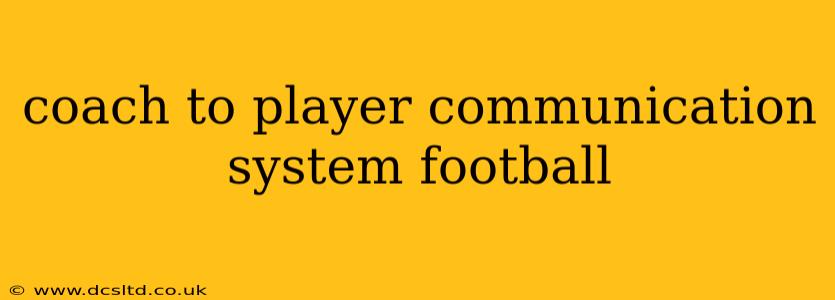Effective communication is the cornerstone of any successful football team. A robust coach-to-player communication system transcends simple shouting from the sidelines; it's a multifaceted strategy encompassing various methods to ensure clear, timely, and impactful messaging. This system directly influences player performance, team cohesion, and ultimately, victory on the field. This article explores the key aspects of this crucial communication system, addressing common questions and providing actionable insights for coaches at all levels.
What are the different ways coaches communicate with players on the field?
Coaches employ a variety of methods to communicate effectively during a game. These range from traditional techniques to technologically advanced solutions. The most common include:
-
Verbal Communication: This classic approach relies on clear, concise instructions yelled from the sidelines, often using hand signals for quick, visual reinforcement. Successful verbal communication necessitates understanding player limitations – distance, noise levels, and the player's concentration on the game itself impact reception.
-
Hand Signals: A universal language on the field, hand signals offer a swift, unambiguous way to convey plays, adjustments, or immediate tactical changes without interrupting the flow of the game. Consistency in signal usage is crucial for effective communication.
-
Whiteboard/Tablet Communication: For more complex strategies or halftime adjustments, visual aids like whiteboards or tablets allow coaches to illustrate plays, formations, or specific player roles with clarity and detail. This helps overcome the limitations of verbal communication in busy and noisy environments.
-
Two-Way Radios: Some levels of football utilize two-way radios, enabling direct communication between the coaching staff and individual players or specific positions on the field. This technology allows for real-time feedback and adjustments during active play.
-
Post-Game Analysis and Feedback: While not technically during the game, detailed post-game analysis and feedback sessions are crucial components of the overall communication system. This allows coaches to address individual and team performance, reinforcing positive actions and correcting errors.
How do coaches ensure players understand their instructions during a game?
Clarity and conciseness are paramount. Coaches must ensure their instructions are:
-
Simple and Direct: Avoid jargon or overly complex instructions. Keep messages brief and focused on the key elements.
-
Visually Reinforced: Hand signals, diagrams, or even pointing directly to the field of play can reinforce verbal instructions, ensuring understanding.
-
Repeated and Reinforced: Especially during crucial moments, repeating instructions can solidify their understanding and ensure everyone is on the same page.
-
Tailored to Individual Players: Recognize that players have varying learning styles and communication preferences. Tailor your communication approach to individual players to ensure effective delivery.
What technology is used in football for coach-to-player communication?
Technological advancements are increasingly shaping coach-to-player communication. Beyond two-way radios, systems are evolving to integrate:
-
GPS Tracking: Real-time tracking of player movement provides valuable data for post-game analysis and helps coaches better understand player performance and positioning on the field.
-
Wearable Technology: Some teams utilize wearable technology that monitors player biometrics (heart rate, exertion levels) giving coaches real-time data on player physical condition. This can inform substitution decisions and training regimens.
-
Video Analysis Tools: High-definition video analysis allows for detailed breakdown of game situations, enabling coaches to identify strengths and weaknesses, and to precisely communicate tactical adjustments.
How can coaches improve their communication skills to be more effective?
Effective communication is a skill that can be honed. Coaches can improve their effectiveness through:
-
Active Listening: Truly hearing and understanding player perspectives is crucial for building trust and rapport.
-
Empathy and Understanding: Recognizing the pressures and challenges players face enhances their receptiveness to coaching.
-
Constructive Feedback: Focus on positive reinforcement while providing specific, actionable criticism.
-
Regular Communication: Maintain open channels of communication outside of game-day scenarios to foster a strong team dynamic.
-
Seeking Feedback: Actively solicit feedback from players to gauge the effectiveness of your communication strategies.
In conclusion, a comprehensive and effective coach-to-player communication system is pivotal for success in football. By embracing a multifaceted approach that combines traditional methods with cutting-edge technology and prioritizing clear, empathetic communication, coaches can significantly improve team performance and foster a winning environment. The evolution of this system will continue as technology advances, but the core principle of clear, consistent, and supportive communication will always remain paramount.
